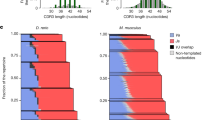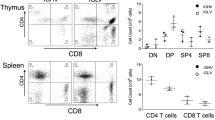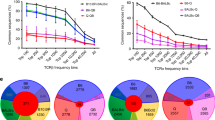Abstract
T cell receptor beta chain (TCRβ) diversity (Dβ) gene segments are highly conserved across evolution, with trout Dβ1 sequence identical to human and mouse Dβ1. A key conserved feature is enrichment for glycine in all three Dβ reading frames (RFs). Previously, we found that replacement of mouse Dβ1 with a typical immunoglobulin DH sequence, which unlike Dβ is enriched for tyrosine, leads to an increase in the use of tyrosine in TCRβ complementarity determining region 3 (CDR-B3) after thymic selection, altering T cell numbers, CDR-B3 diversity, and T cell function. To test whether the incorporation of charged amino acids into the Dβ sequence in place of glycine would also influence T cell biology, we targeted the TCRβ locus with a novel glycine-deficient DβDKRQ allele that replaces Dβ1 coding sequence with charged amino acids in all three reading frames. Developing T cells using DβDKRQ expressed TCR CDR-B3s depleted of tyrosine and glycine and enriched for germline-encoded lysine, arginine, and glutamine. Total thymocytes declined in number during the process of β selection that occurs during the transition from the DN3bc to DN4 stage. Conventional thymocyte and T cell numbers remained reduced at all subsequent thymic stages and in the spleen. By contrast, regulatory T cell numbers were increased in Peyer’s patches and the large intestine. In terms of functional consequences, T cell reactivity to an ovalbumin immunodominant epitope was reduced. These findings buttress the view that natural selection of Dβ sequence is used to shape the pre-immune TCRβ repertoire, affecting both conventional and regulatory T cell development and influencing epitope recognition.








Similar content being viewed by others
References
Adams S, Leblanc P, Datta SK (1991) Junctional region sequences of T-cell receptor beta-chain genes expressed by pathogenic anti-DNA autoantibody-inducing helper T cells from lupus mice: possible selection by cationic autoantigens. Proc Nat Acad Sci USA 88:11271–11275
Bassing CH, Alt FW, Hughes MM, D’Auteuil M, Wehrly TD, Woodman BB, Gartner F, White JM, Davidson L, Sleckman BP (2000) Recombination signal sequences restrict chromosomal V(D)J recombination beyond the 12/23 rule. Nature 405:583–586
Cibotti R, Cabaniols JP, Pannetier C, Delarbre C, Vergnon I, Kanellopoulos JM, Kourilsky P (1994) Public and private V beta T cell receptor repertoires against hen egg white lysozyme (HEL) in nontransgenic versus HEL transgenic mice. J Exp Med 180:861–872
Ippolito GC, Schelonka RL, Zemlin M, Ivanov II, Kobayashi R, Zemlin C, Gartland GL, Nitschke L, Pelkonen J, Fujihashi K, Rajewsky K, Schroeder HW Jr (2006) Forced usage of positively charged amino acids in immunoglobulin CDR-H3 impairs B cell development and antibody production. J Exp Med 203:1567–1578
Irla M (2022) Instructive Cues of Thymic T Cell Selection. Annu Rev Immunol 40:95–119
Ivanov II, Schelonka RL, Zhuang Y, Gartland GL, Zemlin M, Schroeder HW Jr (2005) Development of the expressed immunoglobulin CDR-H3 repertoire is marked by focusing of constraints in length, amino acid utilization, and charge that are first established in early B cell progenitors. J Immunol 174:7773–7780
Jorgensen JL, Reay PA, Ehrich EW, Davis MM (1992) Molecular components of T-cell recognition. Annu Rev Immunol 10:835–873
Khass M, Vale AM, Burrows PD, Schroeder HW Jr (2018) The sequences of immunoglobulin diversity (DH) gene segments play key roles in controlling B cell development, antigen binding site diversity, and antibody production. Immunol Rev 284:106–119
Klein L, Kyewski B, Allen PM, Hogquist KA (2014) Positive and negative selection of the T cell repertoire: what thymocytes see (and don’t see). Nat Rev Immunol 14:377–391
Kyte J, Doolittle RF (1982) A simple method for displaying the hydropathic character of a protein. J Mol Biol 157:105–132
Lefranc MP (2002) IMGT, the international ImMunoGeneTics database: a high-quality information system for comparative immunogenetics and immunology. Dev Comp Immunol 26:697–705
Levinson M, Khass M, Burrows PD, Schroeder Jr HW (2020) Replacement of TCR Dbeta With Immunoglobulin DH DSP2.3 Imposes a Tyrosine-Enriched TCR Repertoire and Adversely Affects T Cell Development. Front Immunol 11:573413
Levinson M, Schelonka RL, Silva-Sanchez A, Kapoor P, Burrows PD, Schroeder HWJ (2018) Substituting an immunoglobulin DH for TCR Db1 alters T cell repertoire development and function. Univ Alabama Birmingham
Ma L, Yang L, Shi B, He X, Peng A, Li Y, Zhang T, Sun S, Ma R, Yao X (2016) Analyzing the CDR3 repertoire with the respect to TCR-Beta chain and V-D-J and V-J rearrangements in peripheral T cells using HTS. Sci Rep 6
Madi A, Shifrut E, Reich-Zeliger S, Gal H, Best K, Ndifon W, Chain B, Cohen IR, Friedman N (2014) T-cell receptor repertoires share a restricted set of public and abundant CDR3 sequences that are associated with self-related immunity. Genome Res 24:1603–1612
Mathieu N, Hempel WM, Spicuglia S, Verthuy C, Ferrier P (2000) Chromatin remodeling by the T cell receptor (TCR)-beta gene enhancer during early T cell development: implications for the control of TCR-beta locus recombination. J Exp Med 192:625–636
Nguyen HH, Zemlin M, Vu HL, Ivanov II, Andrasi J, Zemlin C, Schelonka RL, Schroeder HW Jr, Mestecky J (2007) Heterosubtypic immunity to influenza A virus infection requires a properly diversified antibody repertoire. J Virol 81:9331–9338
Noonan DJ, Kofler R, Singer PA, Cardenas G, Dixon FJ, Theofilopoulos AN (1986) Delineation of a defect in T cell receptor beta genes of NZW mice predisposed to autoimmunity. J Exp Med 163:644–653
Ou JWS, Brodsky MH, Zhu LJ (2018) motifStack for the analysis of transcription factor binding site evolution. Nat Methods 15:8–9
Rajewsky K (1996) Clonal selection and learning in the antibody system. Nature 381:751–758
Shah DK, Zuniga-Pflucker JC (2014) An overview of the intrathymic intricacies of T cell development. J Immunol 192:4017–4023
Teague TK, Tan C, Marino JH, Davis BK, Taylor AA, Huey RW, Van De Wiele CJ (2010) CD28 expression redefines thymocyte development during the pre-T to DP transition. Int Immunol 22:387–397
Vale AM, Kapoor P, Skibinski GA, Elgavish A, Mahmoud TI, Zemlin C, Zemlin M, Burrows PD, Nobrega A, Kearney JF, Briles DE, Schroeder HW Jr (2013) The link between antibodies to OxLDL and natural protection against pneumococci depends on DH gene conservation. J Exp Med 210:875–890
Wang C, Sanders CM, Yang Q, Schroeder HW Jr, Wang E, Babrzadeh F, Gharizadeh B, Myers RM, Hudson JR Jr, Davis RW, Han J (2010) High throughput sequencing reveals a complex pattern of dynamic interrelationships among human T cell subsets. Proc Natl Acad Sci USA 107:1518–1523
Yoshida RYTYSMTT-MTTYSR (2000) A new method for quantitative analysis of the mouse T-cell receptor V region repertoires: comparison of repertoires among strains. Immunogenetics 53:35–45
Zemlin M, Schelonka RL, Ippolito GC, Nitschke L, Pelkonen J, Rajewsky K, Schroeder Jr HW (2007) Forced use of DH RF2 sequence impairs B cell development. In Kalil J, Cunha-Neto E, Rizzo LV (eds.) 13th International Congress of Immunology. Medimond Intern Proc Bologna
Acknowledgements
We thank Pratibha Kapoor and Yingxin Zhuang for assistance with the creation of the targeting constructs and the gene targeting. We thank Robert Schelonka for assistance in planning the studies and Barry Sleckman for contributing the original DB2KO construct and for reviewing and discussing the results of our studies.
Funding
This work was supported, in part, by AI090902 (HWS) and AI163555 (HWS).
Author information
Authors and Affiliations
Contributions
ML took the lead role in performing the FACS analysis of T cell subsets, the sequencing of the thymocyte and T cell subsets, sequence analysis, performing the ovalbumin challenge, preparing of the figures, and writing initial version of the manuscript. MK participated in interpreting and analyzing the data, and in revising and editing the manuscript. Both ML and MK contributed equally to the manuscript. PDB participated in the planning of the experiments, in interpreting the data and in editing the manuscript. HWS developed the concept of the project, directed the planning and execution of the studies, reviewed the data, and directed the writing of the manuscript.
Corresponding authors
Ethics declarations
Conflict of interest
The authors declare no competing interests.
Additional information
Publisher's Note
Springer Nature remains neutral with regard to jurisdictional claims in published maps and institutional affiliations.
Rights and permissions
Springer Nature or its licensor (e.g. a society or other partner) holds exclusive rights to this article under a publishing agreement with the author(s) or other rightsholder(s); author self-archiving of the accepted manuscript version of this article is solely governed by the terms of such publishing agreement and applicable law.
About this article
Cite this article
Levinson, M., Khass, M., Burrows, P.D. et al. Germline-enforced enrichment for charged amino acids in TCR beta chain (TCRβ) complementarity determining region 3 (CDR-B3) alters T cell development, repertoire content, and antigen recognition. Immunogenetics 75, 341–353 (2023). https://doi.org/10.1007/s00251-023-01304-w
Received:
Accepted:
Published:
Issue Date:
DOI: https://doi.org/10.1007/s00251-023-01304-w




